
views
- Feed your hedgehog a well-balanced, high protein diet with plenty of veggie and fruit treats.
- Buy or make your hedgehog an enclosure that’s at least 2 ft × 4 ft (0.61 m × 1.22 m).
- Bathe your hedgehog at least once a month, and trim their nails weekly.
- Play and snuggle with your hedgehog for at least 30 minutes every day.
Feeding Your Hedgehog

Give your hedgehog a well-balanced diet that’s high in protein. The best way to do this is to feed your little friend dry commercial hedgehog food. These kibble-like pieces are packed with everything your hedgehog needs on a daily basis. Dry cat food that’s high in protein and contains primarily chicken is a great alternative to commercial hedgehog food. Try giving your hedgehog canned dog or cat food that’s primarily chicken as a treat every now and then. Pick a food that’s below 15% fat, around 32 to 35% protein, and has no by-products. Provide about 1–2 tablespoon (15–30 ml) of dry food every day. The amount of food you give your hedgehog depends on their activity level, size, and age. Talk with your veterinarian to see what amount is best for your hedgehog.

Treat your hedgehog with vegetables and fruits. When your hedgehog’s on their best behavior, treat them with something special like beans, peas, corn, apples, and carrots. Chop the treat up into kibble-sized pieces and hand them to your hedgehog or sprinkle them into their regular food. Avoid giving your hedgehog grapes or raisins as they can be toxic. Stay clear of feeding your hedgehog milk and bread as they can cause diarrhea.

Toss in an insect once in a while. If your hedgehog’s being extra good, reward them with a special treat: bugs. Hedgehogs love mealworms and crickets—just make sure you purchase these treats at a pet store rather than catch them outside to avoid unwanted parasites or pesticides. Pick up a live mealworm with a pair of tweezers and dangle it in front of your hedgehog to “hunt.” Try freezing live insects on a baking sheet, so they’re easier to give to your hedgehog.

Feed your hedgehog using a heavy bowl. A hedgehog’s little paws can easily knock over a dish, splashing their dinner all around them. To avoid this, give dry or soft foods and treats in a heavy, low-lipped ceramic dish or food bowl.

Use a hanging bottle or heavy bowl to give your hedgehog water. It’s very important that your hedgehog has fresh, clean water to drink throughout the day. Purchase a hanging water bottle that can dangle on the inside of the enclosure, or place a water dish next to their food dish. Check the water regularly throughout the day, filling it whenever it’s empty and changing it when it gets dirty. Wash the bottle or dish every other day to keep the water and container fresh.
Housing Your Hedgehog

Give your hedgehog a 2 ft × 4 ft (0.61 m × 1.22 m) enclosure. Hedgehogs may be tiny, but they love to run and scurry! Setting up or building an enclosure that’s big enough to house all their toys, burrows, and needs is crucial to their happiness. Opt for an enclosure that’s at least 2 ft × 4 ft (0.61 m × 1.22 m), but consider aiming for something even bigger. Make sure the enclosure has a solid floor, as wire flooring could damage your little hedgehog’s feet. Think about buying an enclosure with multiple levels. This way, your little friend will have plenty of places to explore and hide. Consider using an unlidded, large plastic bin for a cheaper enclosure option.

Place the enclosure in a warm environment that’s around 75 °F (24 °C). Try to keep the enclosure between 75 °F (24 °C) and 80 °F (27 °C), as anything below 70 °F (21 °C) could trick your hedgehog into hibernating. Put a thermometer on the under inside of the enclosure and place it away from air conditioners, fans, and open windows.
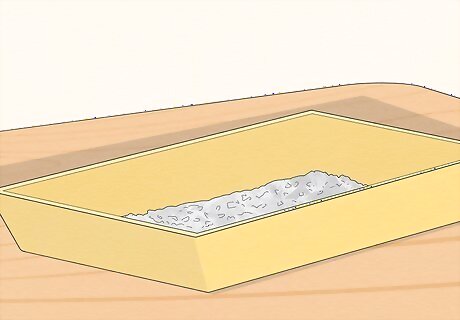
Cover the enclosure with a paper substrate. Hedgehogs love to nestle—it helps them feel safe—so give them a comfortable bedding to do so. Layer the bottom of the enclosure with a paper bedding to about 1 inch (2.5 cm) think. This will give your hedgehog plenty of cushion. Try using fleece blankets or fabric as substrate—just make sure there are no loose strings or tears. Never put wood shavings in your hedgehog’s enclosure as it could cause cancer and respiratory illness. Some hedgehog owners like to use commercial bedding products like Carefresh; however, experts advise against it as the particles of this material can easily get lodged in a hedgehog’s genitals and quills. Change out bedding and clean the enclosure at least once a week to keep your hedgehog’s living space nice and tidy.
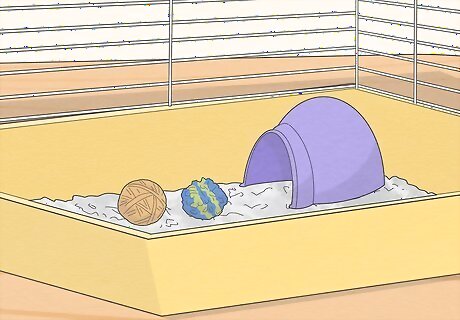
Put toys and hideaway holes inside the enclosure. Give your hedgehog plenty to do with an igloo or hideout, exercise wheel, bells, and balls. Adding these items to their habitat will make them happy and keep them occupied day and night. Exercise and rest are crucial for a hedgehog, so make sure there are toys and places to sleep. Tubing and piping are great places for hedgehogs to hide, sleep, and run around in. Purchase an exercise wheel with a solid base, not wired.
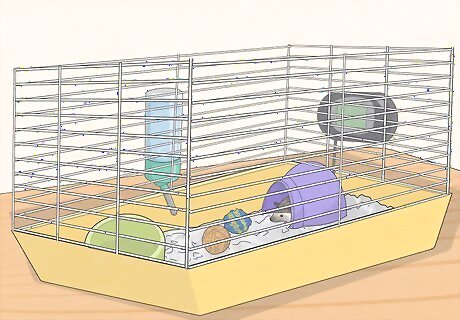
Keep the hedgehog in a quiet space where noise levels are low. Loud noises can cause hedgehogs to become jittery and fearful. Because of this, make sure to put your hedgehog’s enclosure in a quiet area. Place it in a back room, secluded office, or far-off hallway.
Grooming Your Hedgehog
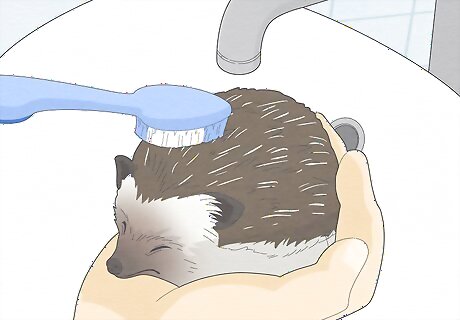
Bathe your hedgehog once a month. Hedgehogs are rather clean animals, but they still tend to get dirty from time to time. Aim to bathe your hedgehog at least once a month on top of cleaning their enclosure regularly. Fill a sink with about 1 in (2.5 cm) of warm water. Place the hedgehog in the sink gently, being careful not to get their face or ears wet. Use a toothbrush to scrub the quills gently, and rub the underside of the belly with your fingertips. Take the hedgehog out of the water and dry them with a towel.

Trim your hedgehog’s toenails regularly. Surprisingly, a hedgehog’s toenails grow rather fast, which means they must be cut every so many days. Run a fingertip along their feet while handling your hedgehog. If their toenails scratch you, it may be time for a trim. Gently grab your little friend’s foot and wait a few seconds for them to relax. Then, use hedgehog nail clippers to trim off the tiniest amount of nail. If the nail bleeds after trimming, you’ve cut off too much nail. If you have trouble trimming your hedgehog’s nails, talk to your veterinarian about scheduling regular nail trimming appointments.

Ease quilling symptoms with oatmeal baths and gentle care. The points on a hedgehog are called spines, and quilling is the process of shedding these spines (think of it as losing baby teeth or a snake shedding its skin). Quilling is natural and completely normal, especially as a hedgehog matures. If you notice spines sprinkled around their enclosure, consider taking some of these measures to help comfort your hedgehog through the process: Give them an oatmeal bath by filling a sock with old fashioned oats and placing it in their bath water Let your hedgehog crawl around your hands rather than being snuggled or pet Monitor their behavior and leave them be if they’re irritable
Additional Hedgehog Care
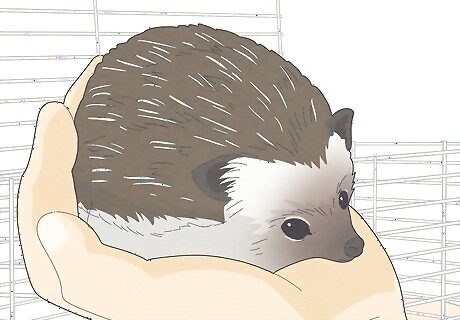
Play and hold your hedgehog daily to bond with them. Some hedgehogs can be shy at first, so it’s important to handle them frequently, so they get used to you. Aim to pick up and play with your hedgehog outside their enclosure for at least 30 minutes each day. Approach your little friend quietly and slowly, and pick them up by placing a hand gently under their belly in a cupping motion. Be confident while holding your hedgehog—they’ll feel that energy! Let your hedgehog sniff your hands, crawl in your lap, or chase a ball you roll across the floor.

Keep a watchful eye on your hedgehog’s behavior. Hedgehogs are notoriously good at hiding ailments, so pay close attention to their eating habits and mood. Check your hedgehog’s quills, skins, and feet whenever you handle them, and monitor how much they’re eating and drinking. Bring your little friend to a veterinarian if you notice any of these behaviors or symptoms: Not eating or drinking for more than 2 days could be a sign of fatty liver disease or illness. Dry, scaly skin around the quills could be from mites. Wheezing or crackly breathing could result from a respiratory infection. Soft stools could be from a parasite or illness. Lethargy or cool belly could be a sign of hibernation.

Respect your hedgehog’s nocturnal schedule. Your little friend is naturally a night owl, meaning they love to scurry around when the sun goes down. Because of this, you may find that your hedgehog is more active at night and sleepier during the day. Honor their natural patterns by letting them sleep and wake naturally. If you’re not on the same night owl schedule as your hedgehog, consider placing their enclosure outside your bedroom. This way, your pet won’t wake you while they play during the night.



















Comments
0 comment